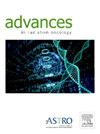Pro-Grid的中期分析:一期质子空间分割放射治疗试验
IF 2.7
Q3 ONCOLOGY
引用次数: 0
摘要
空间分割(SFRT)是一种通过在肿瘤内交替输送高、低剂量来靶向大体积肿瘤的放射治疗技术。在这里,我们报告了一项1期试验的中期分析,该试验检验了一种新型质子SFRT方法的可行性和安全性。方法和材料:在姑息治疗环境下,不可切除的不同组织病理学肿瘤至少为7厘米的患者被纳入前瞻性1期试验。稳健的铅笔束扫描质子SFRT计划是使用圆柱形(网格)靶标在总体肿瘤内治疗到处方剂量为18 Gy的单个部分。质量保证在治疗交付前进行计算机断层成像(qCT)。结果乳腺原发4例,肺原发3例,盆腔原发3例。5例患者先前接受过不同部位的光子治疗。8名患者接受了额外的计划放射治疗,平均剂量为30 Gy。从SFRT治疗到最后一次随访的中位时间为25周(范围4-60周)。大体肿瘤体积为151 ~ 1638 cm³。所有的qct都保持了健壮性,不需要重新规划。在最后一次随访中,40%表现出部分缓解,20%病情稳定,40%出现疾病进展,其中一半在治疗区域进展。1例接受盆腔治疗的患者出现3级小肠梗阻,随后出现2级晚期梗阻。没有其他患者有3级或更高级别的急性或晚期毒性归因于质子SFRT。结论:使用新型铅笔束扫描SFRT技术进行空间分割在技术上是可行的,并且在难以处理的大体积肿瘤患者的小前瞻性队列中可靠地进行了qCT的稳健评估。质子SFRT是安全的,即使在额外的正放射治疗的情况下。一些体积较大的肿瘤对质子SFRT有明显的反应;因此,进一步阐明哪些患者最受益于这项技术是有必要的。本文章由计算机程序翻译,如有差异,请以英文原文为准。
Interim Analysis of Pro-Grid: A Phase 1 Proton Spatially Fractionated Radiation Therapy Trial
Purpose
Spatial fractionation (SFRT) is a radiation therapy technique that targets bulky tumors by delivering alternating high and low doses within the tumor. Here, we report an interim analysis of a phase 1 trial examining the feasibility and safety of a novel proton SFRT approach.
Methods and Materials
Ten patients with unresectable tumors of varying histopathology measuring at least 7 cm in the palliative setting were enrolled in a prospective phase 1 trial. Robust pencil-beam scanning proton SFRT plans were created using cylindrical (grid) targets within gross tumor treated to a prescription dose of 18 Gy in a single fraction. Quality assurance computed tomography imaging (qCT) was performed before treatment delivery.
Results
Four patients had breast primaries, 3 patients had lung primaries, and 3 patients had pelvic primaries. Five patients had prior photon treatment to a different site. Eight patients received additional planned normofractionated radiation therapy totaling an average dose of 30 Gy. Median time from SFRT treatment to last follow-up was 25 weeks (range, 4-60 weeks). Gross tumor volume ranged from 151 cm³ to 1638 cm³. All qCTs maintained robustness, with no re-planning needed. At last follow-up, 40% showed partial response, 20% had stable disease, and 40% experienced disease progression, with half progressing in the treated area. One patient with pelvic treatment developed grade 3 small bowel obstruction, followed by late grade 2 obstructions. No other patients had grade 3 or higher acute or late toxicities attributable to the proton SFRT.
Conclusions
Spatial fractionation using a novel pencil-beam scanning SFRT technique was technically feasible to deliver and reliable on robust evaluation of qCT in this small prospective cohort of patients with difficult-to-manage bulky tumors. Proton SFRT appears safe even when additional normofractionated radiation therapy is delivered. Some bulky tumors exhibited significant response to proton SFRT; thus, further work elucidating which patients most benefit from this technique is warranted.
求助全文
通过发布文献求助,成功后即可免费获取论文全文。
去求助
来源期刊

Advances in Radiation Oncology
Medicine-Radiology, Nuclear Medicine and Imaging
CiteScore
4.60
自引率
4.30%
发文量
208
审稿时长
98 days
期刊介绍:
The purpose of Advances is to provide information for clinicians who use radiation therapy by publishing: Clinical trial reports and reanalyses. Basic science original reports. Manuscripts examining health services research, comparative and cost effectiveness research, and systematic reviews. Case reports documenting unusual problems and solutions. High quality multi and single institutional series, as well as other novel retrospective hypothesis generating series. Timely critical reviews on important topics in radiation oncology, such as side effects. Articles reporting the natural history of disease and patterns of failure, particularly as they relate to treatment volume delineation. Articles on safety and quality in radiation therapy. Essays on clinical experience. Articles on practice transformation in radiation oncology, in particular: Aspects of health policy that may impact the future practice of radiation oncology. How information technology, such as data analytics and systems innovations, will change radiation oncology practice. Articles on imaging as they relate to radiation therapy treatment.
 求助内容:
求助内容: 应助结果提醒方式:
应助结果提醒方式:


